Agricultural Sciences
Vol.4 No.12(2013), Article ID:40647,8 pages DOI:10.4236/as.2013.412086
Indigenous knowledge of seasonal weather forecasting: A case study in six regions of Uganda
![]()
1International Potato Center (CIP), Kampala, Uganda; *Corresponding Author: j.okonya@cgiar.org
2International Potato Center (CIP), Lima, Peru
Copyright © 2013 Joshua S. Okonya, Jürgen Kroschel. This is an open access article distributed under the Creative Commons Attribution License, which permits unrestricted use, distribution, and reproduction in any medium, provided the original work is properly cited.
Received 3 October 2013; revised 6 November 2013; accepted 22 November 2013
Keywords: Climate Change; Agricultural Meteorology; Early Warning Systems; Oral Tradition; Weather Lore; Uganda
ABSTRACT
Indigenous knowledge of seasonal weather forecasting could be useful in decision making at village level to best exploit the seasonal distribution of rainfall in order to increase or stabilize crop yields. We examined existing indigenous knowledge by interviewing 192 households in six regions of Uganda. Twenty one distinctive indicators were mentioned by local communities for forecasting the start of the dry season, but only few of these indicators were more consistently and frequently used in the different districts. These included the appearance of bush crickets (Ruspolia baileyi Otte), winds blowing from the east to the west, the appearance and movement of migratory birds such as cattle egrets (Bubulcus ibis Linnaeus), and calling by the Bateleur eagle (Terathopius ecaudatus Lesson). For prediction of the start of the rainy season, 22 indicators were mentioned and these included winds blowing from the west to the east, cuckoo birds (Cuculiformes: Cuculidae) start to call, and winged African termite (Coptotermes formosanus Shiraki) swarms leave their nests. Predictors of rain in the following days included presence of red clouds in the morning. Together with the meteorological forecasts, traditional indicators could be very useful in rain forecasting and improving the timing of agricultural activities.
1. INTRODUCTION
Adverse effects of climate change are threatening to undo decades of development efforts and negatively impact agriculture, health, settlements, and infrastructure in developing countries [1-3]. Agriculture in Uganda, like in most of sub-Saharan Africa is mainly rainfed and a drought will mean household food insecurity as a result of complete crop failure [4]. Rainfall variability together with the occurrence of extreme weather events like droughts, floods, and landslides is a reality in Uganda (Table 1) and is threatening livelihoods and ecosystems alike [5-10].
Early warning systems have proven to be indispensable in preparedness for climatic events like the onset of rainfall, floods, earthquakes, landslides, droughts and related famine, and tsunami [11-14]. In West Africa, Tall et al. [15] and Braman et al. [16] demonstrated how seasonal rainfall forecast information was used to reduce loss of lives, property, and illness due to floods. Efficient early warning systems have been shown to greatly reduce mortality and morbidity due to extreme weather events in the health sector [17].
The knowledge of the indigenous people should be included when designing adaptations to climate change especially in Africa [18]. Local communities and farmers have developed a rich knowledge base of predicting climatic and weather events based on observations of animals, plants, and celestial bodies, among others [19]. Roncoli et al. [20] demonstrated that indigenous knowledge on rainfall forecasting can form an important part of the scientific forecasts in Burkina Faso. It was urged that understanding how local communities perceive and predict rainfall variability is key to communicating scientific weather forecasts. The most common environmental indicators used by the Bonaman inhabitants of Burkina Faso were the occurrence of intense heat and/or cold at different times of the year indicating the timing and amount of rainfall in the upcoming rainy season and the fruiting of specific tree species to either mean abundant rain or drought.
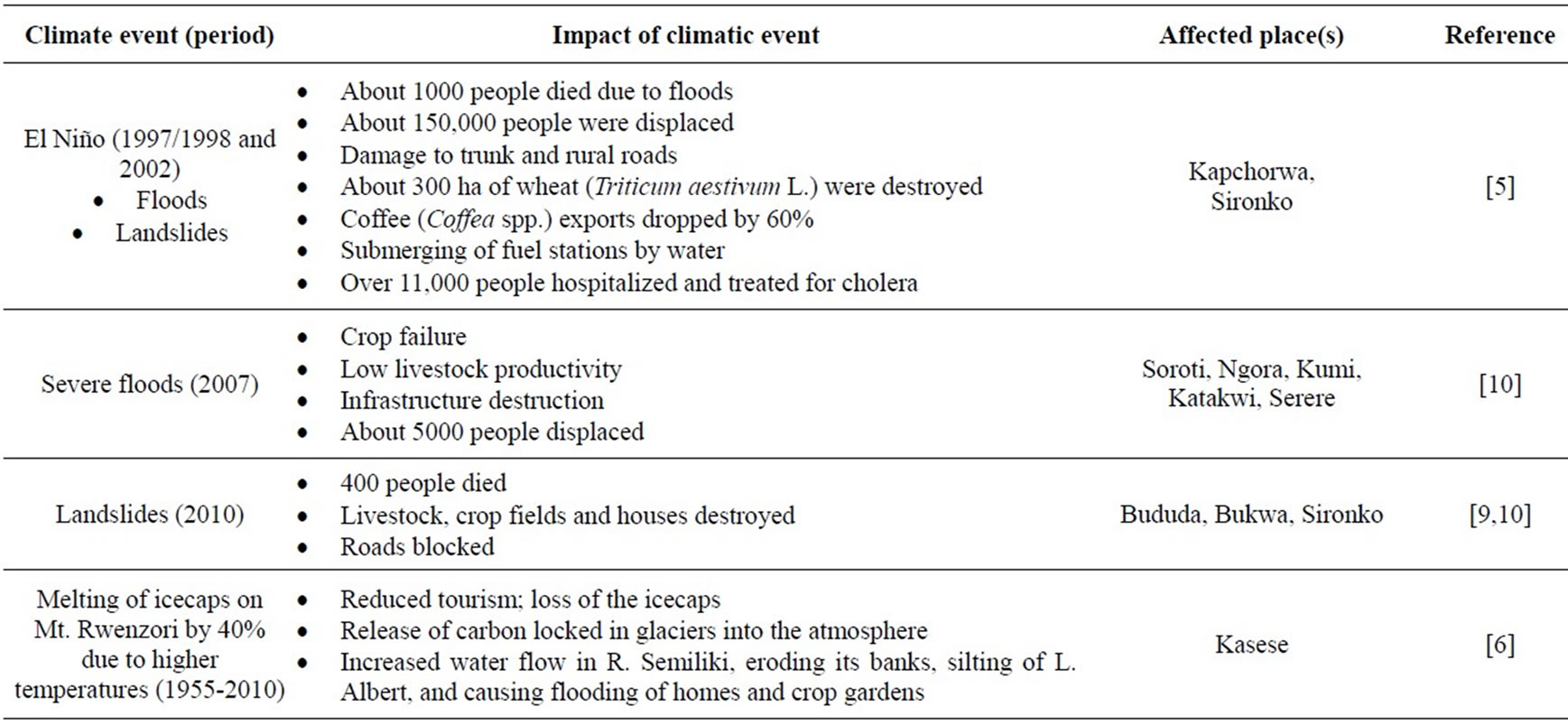
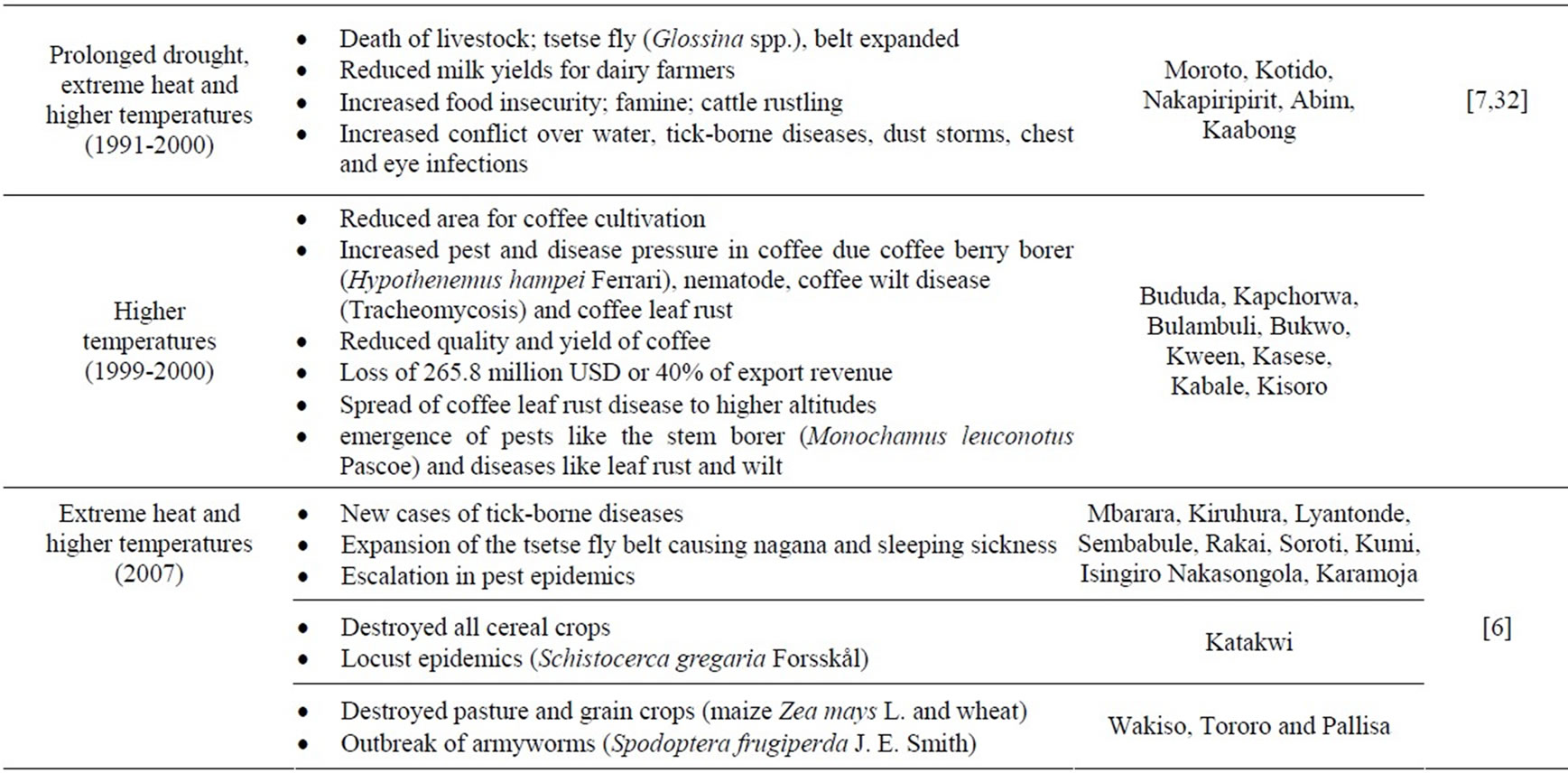
Table 1. Occurrence of some extreme climatic events over the last 20 years in Uganda.
In the rural villages of Rajasthan, India, Pareek and Trivedi [21] investigated cultural values and indigenous knowledge of climate change and disaster prediction. They established that traditional knowledge systems were an important tool in environmental conservation and natural disaster management. Tree (Ficus spp.) flowering and generation of new shoots, appearance of termites, ants, butterflies, and frogs indicated the near rainfall onset. In Mberengwa district of Zimbabwe, interviews of persons over 70 years of age revealed a number of traditional weather forecasting indicators including birds (southern ground hornbill, Bucorvus leadbeateri Vigors, rain cuckoo), invertebrates (termites, cicadas), and vertebrates (frogs), fruiting of the ebony tree (Diospyros kirkii Hiern) among others [22]. In the southwestern highlands of Tanzania, Chang’a et al. [23] documented a good number of signs relied on by the local communities to predict the start and intensity of the rainy season and these included behavior of insects (armyworms, grasshoppers, termites, and butterflies), behavior of birds like the swallow-tailed bee-eater (Merops hirundineus Lichtenstein), plant phenology, like the flowering intensity of trees, and wind direction, among others. Elders in Manicaland and Masvingo provinces in Zimbabwe rely on a vast number of biological (singing of nyenze insects, collecting of grass and food by ants and termites to mark the start of the rainy seasons), atmospheric (frequent occurrence of mist or fog on mountain tops for the start of rain), and astronomic (position of the Milky Way and a group of six stars in the sky) weather forecasting indicators [24,25].
In India, Anandrajaga et al. [26] identified fifteen traditional weather and climate related practices that farmers of Tamil Nadu, Coimbatore district follow in their farming systems to help them in forecasting weather events. These included insect behavior (termites, ants, and dragon flies), frogs’ croaking, dense fog in the morning, and high sweating during the day, among others.
In addition to the vulnerability of Uganda to rainfall variability and climatic shocks like droughts and floods [6,9], there is also lack of timely weather forecasts at local village or district levels. This coupled with high poverty levels, high dependence on rainfed agriculture and the dependence of up to 80% of the population’s livelihood on agriculture leave most smallholders and resource-constrained rural farmers unable to adapt to climate change. Reducing the impact of extreme climatic events, however, remains a challenge in Uganda because disasters are responded to after they have occurred rather than preparing for them and implementing a risk management plan.
Uganda’s system for generating official early warning systems at national, regional, district, or village levels for disaster management is non-existing and this puts farmers and the entire population in the awkward position of being unable to adequately prepare for extreme climatic events. Additionally, the literature has only limited studies detailing actual early warning systems for each of the regions in Uganda and yet each culture has unique traditions of predicting climatic events. There is thus a need to document location-based traditional early warning signs of climatic and weather events used by farmers. This study was therefore undertaken to document local pointers used to forecast the start and end of the rainy and dry seasons over the districts under study.
2. METHODS AND MATERIALS
A total of 192 households (32 households per district and region), were interviewed from six districts: Soroti (Teso region), Masindi (Bunyoro region), Wakiso (Buganda region), Gulu (Acholi region), Kabale (Kigezi region), and Kasese (Tooro region) in Uganda. Two subcounties were randomly selected per district and in each sub-county four parishes were chosen by lot. Four villages were then selected per parish. One household was randomly selected per village except that in villages which spanned over 10 km of road distance, two households were picked. Respondents who had lived in the village for the past 10 years and preferably older than 30 years were mainly targeted. Interviews of the selected respondents were conducted in their homes using openended questionnaires. This gave the respondents an opportunity to describe important features of their local weather forecast systems while detailing features that are important for them. Information on demographic characteristics and indigenous knowledge of forecasting the onset of the rain and dry seasons was collected. Data were mainly qualitative and percentages were the major statistical tools used to enable the description of sociodemographic characteristics and early warning signs used by farmers for prediction of climatic events.
3. RESULTS AND DISCUSSION
3.1. Household Characteristics
Of the 192 respondents that were interviewed, the majority (61%) were women. According to UNHS 2009/ 2010 [27], more than half of Uganda’s population is female (51%). In all the six districts surveyed, most of the households interviewed were male-headed (72%) and this compares well with the national figure of 71% in rural areas of Uganda [27]. Nearly 90% of the respondents were aged 30 years or older (Table 2) which was the main target group for this study. Mean household size across districts was 7.5 members and this is higher than the national average by 2.5 members. The majority of respondents (75%) had zero to seven school years. For their livelihood, respondents grew crops (36%), kept livestock (3%), or did both (45%).
3.2. Indigenous Early Warning Signs of Climatic Events
Historically and still today in Uganda, as elsewhere in Africa and the world, farmers continue to use traditional knowledge to understand rainfall patterns and other climatic events. In this study, a number of signs were relied on by respondents to predict the start of the dry season (Table 3). Appearance and movement of insects as an indicator of the approach of the start of the dry season was the most mentioned local sign only in the districts of Wakiso (34%), Masindi (31%), and Kasese (6%). In Wakiso district, nsenene (bush crickets, Ruspolia baileyi Otte) usually appear in the months of May and November every year and the dry seasons normally start in June and December. Winds blowing from the east to the west were mentioned in all six districts as a sign of an upcoming dry season. Indicators of the nearness of the dry season that were specific to a district were coldness during the night and day, and the presence of red clouds in the morning hours in Kasese district. In Masindi district, coldness in the morning and evening, new moon appearing red without a lining, winds blowing from the west to the south/north, movement of white clouds from the east to the west and strong winds coming with rain in a storm indicated that the dry season is near. Indicators like the presence of fog in the morning, strong winds in the

Table 2. Mean age of respondents (% per age group).
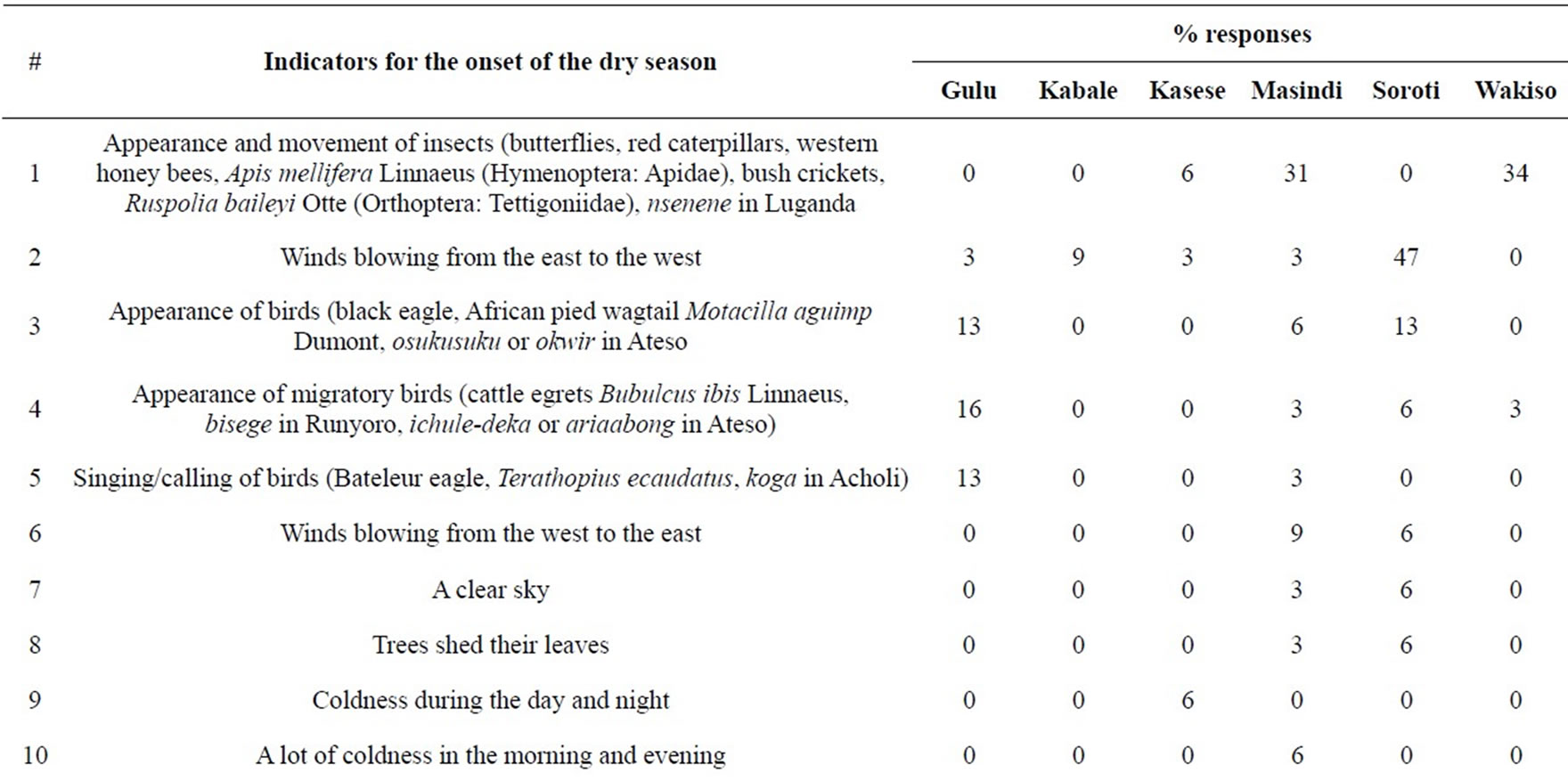

Table 3. Early warning signs used by farmers for prediction of the start of the dry season.
morning and evening, and the moon appearing black were specific only to Wakiso district. Soroti district had the largest number of respondents using local indicators to predict the onset of the dry season (84%), followed by Masindi district (56%), while Kabale district had the lowest number of respondents using local indicators to mark the start of the dry season. When farmers observed indicators for the nearness of the dry season, they responded by either storing food in granaries or planting only in swampland where water is available even during the dry season.
Although, respondents in Masindi district mentioned that the appearance of cumulus humilis clouds in a clear sky indicated the start of a dry season, meteorologists use these clouds to forecast a dry day as they produce little or no precipitation [28]. In Kasese district, a red sunset was taken to indicate the nearness of the dry season but Schott [29] believes this forecast is for no rain during the next day.
Farmers used a number of indicators to forecast the start of the rainy season (Table 4). Winds blowing from the west to the east are the most common sign and this was reported in five out of the six districts. The appearance of nimbus clouds in the morning and evening used by communities in all the six districts was the second most mentioned sign, while calling by birds came third. Signs for forecasting rains specific to a district were movement of clouds from the west to the east in Masindi, appearance of algae in Kabale, cows becoming restless in Gulu, visibility of the ice cap on Mt. Rwenzori in Kasese, sight of a group of small stars in the east in Soroti, and appearance of millipedes and the presence of dew on grass in Wakiso.
After the first soaking rain of the rainy season, winged termites commonly known as white ants leave their nest in large swarms. These termites are a delicacy in Uganda and represent a valuable source of protein and fat in the diet of many Ugandans. Some of these early warning
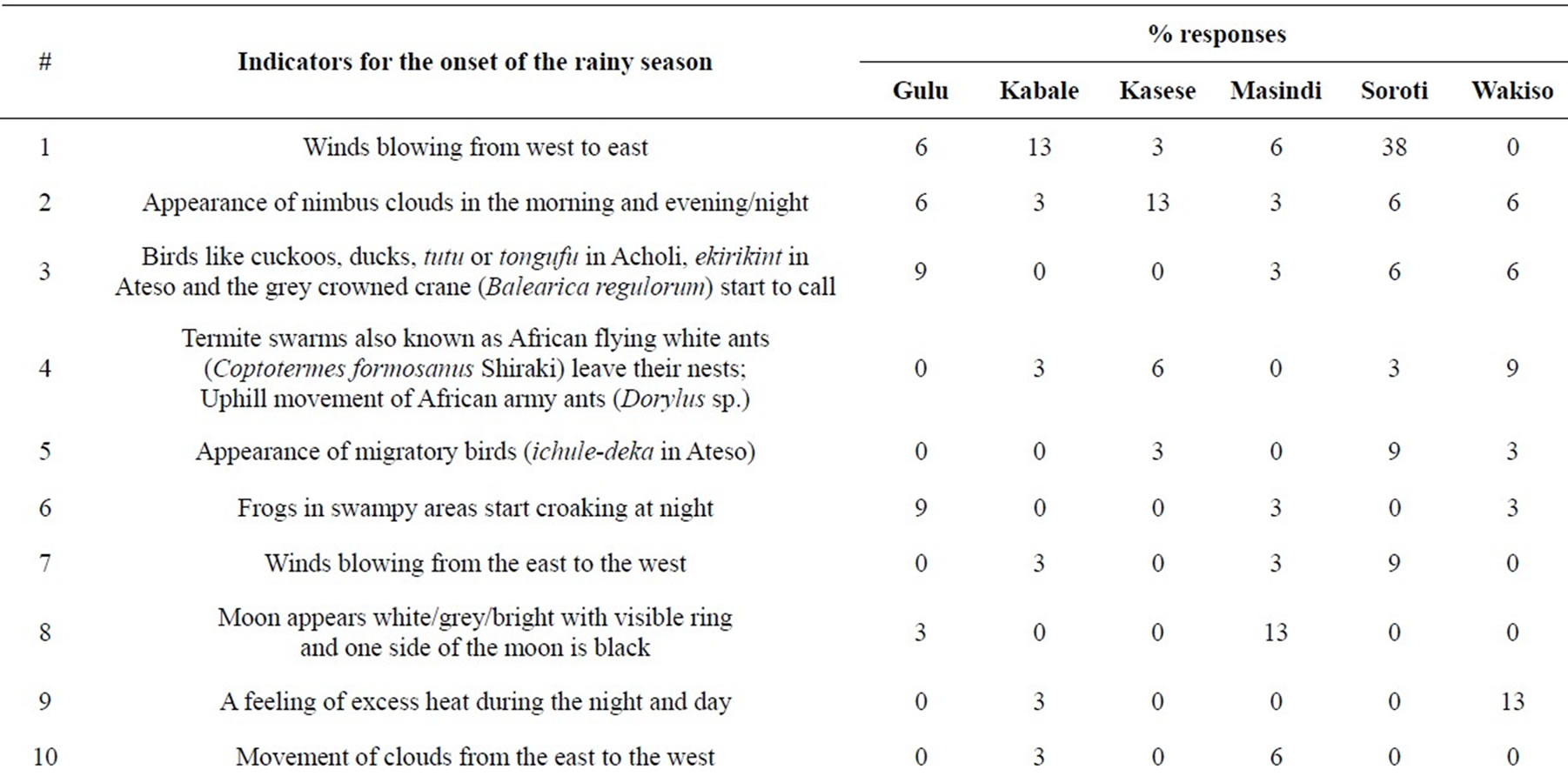
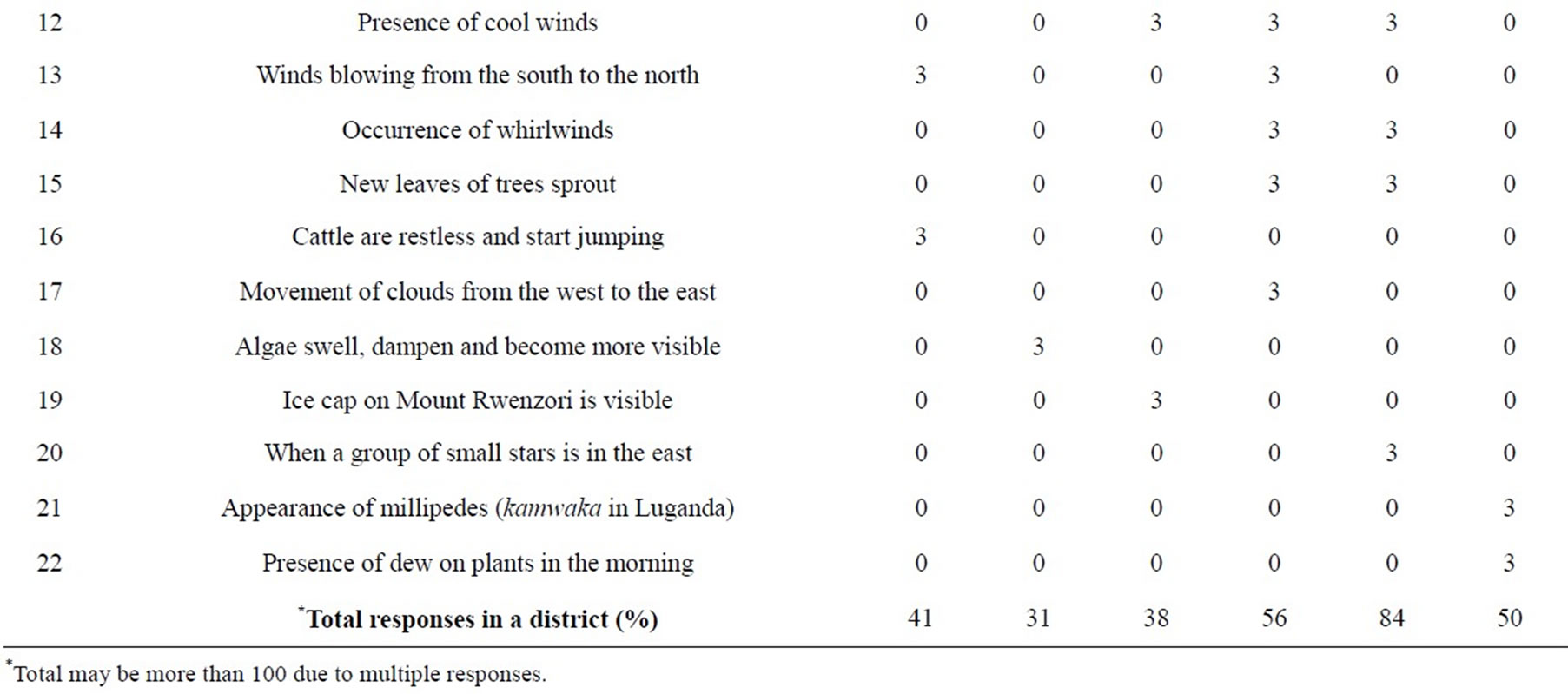
Table 4. Early warning signs used by farmers for prediction of the start of the rainy season.
signs, such as watching the behavior of a herd of cows, require patience and are not stand-alone thereby requiring a combination of two or more other signs to be able to make an accurate weather forecast. Acharya [19] proposed that the behavior of animals can reliably be used to predict the onset of the rainy season, upcoming rain, and the occurrence of floods or typhoons since animals alter their behavior to suit upcoming natural dangers. Cattle are believed to sense when the rains are near and they become frisky which is demonstrated by jumping. The cry and movement of birds to signal the onset of the rains has been reported by local communities in India [19], Tanzania [23] and, Swaziland [30], though these are unlikely to be the same species as the birds observed in Uganda.
Indicators for rain over coming days were not as many as those for the start of the seasons and included a feeling of excess heat, presence of many rain clouds, a red sky in the morning, appearance of fog in the morning, and a feeling of body pains by some individuals (Table 5).
Other early warning signs reported by respondents were for hailstorms (3% in Kabale and 9% in Soroti) and ceremonies for rainmakers. Cultural rituals to ask the gods for rain were performed by very few respondents (6% in Soroti, 3% in Wakiso and Soroti). In Wakiso; the rituals involved drinking a local brew (malwa), performing cultural dances while drumming, and singing to tree called nyagalabwami on a sacred hill (sekwa).
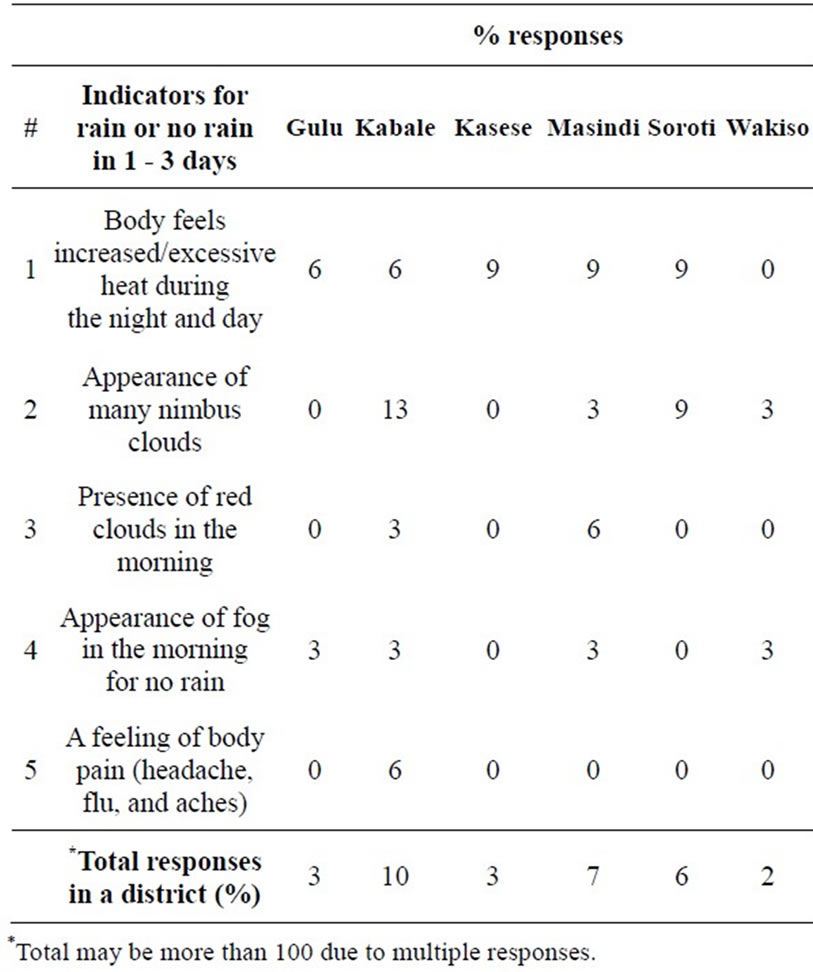
Table 5. Early warning signs used by farmers for prediction of rain or no rain in 1 - 3 days.
It should also be noted that observations for forecasting the weather based on the sun, moon, sky/clouds, dew, or fog may be the same in all districts and even countries since they refer to the same planet earth. Observations based on certain birds, plants, insects, and animals may however vary from one region to another because they are unique or specific to a certain locality. The variation in indicators across regions for prediction of weather events observed in this study could partly be explained by the difference in individuals’ experience, knowledge, and culture of the people in these regions.
Although some of these signs may not be consistent, a good number of them do have a scientific explanation mainly based on pressure (barometric and hydrostatic) zones. Such signs include a halo around the moon, feeling of body pains and aches, fog in the morning, cows’ behavior, red sky, and wind direction [19,29,31].
Results of this survey, however, find relevance in areas with similar birds, plants, insects, and animals in Uganda and elsewhere in the tropics. This knowledge can facilitate adaptation to erratic and unpredictable rainfall events in rural areas with no access to conventional weather forecasting from the department of meteorology.
4. CONCLUSIONS, RECOMMENDATIONS AND POLICY IMPLICATIONS
Local indicators used by smallholder farmers for seasonal rainfall prediction have been identified in various districts of Uganda. Not all respondents are familiar of using traditional signs to predict seasons. It was also noted that recent changes in climate are affecting the use of traditional signs for forecasting the start of the rainy season. Hence, farmers would profit from weather forecasts provided by governmental institutions. This will enable farmers to make sound decisions on how to fully exploit the seasonal distribution of rainfall to improve and stabilize crop yields.
5. ACKNOWLEDGEMENTS
The authors are grateful to the German Federal Ministry for Economic Cooperation and Development (BMZ) for funding this project. This study was carried out under the project “Predicting climate change induced vulnerability of African agricultural systems to major insect pests through advanced insect phenology modeling, and decision aid development for adaptation planning”. We are also thankful to Ms. Katja Syndikus and Ms. Zaamu Ssempa for their support during data collection. The respondents are also appreciated for sharing this valuable traditional ecological or environmental knowledge.
REFERENCES
- IPCC (Intergovernmental Panel on Climate Change) (2007) Climate change 2007: The physical science basis. In: Averyt, K.B., Tignor, M. and Miller, H.L., Eds., Contribution of Working Group I to the Fourth Assessment Report of the Intergovernmental Panel on Climate Change, Cambridge University Press, Cambridge. http://www.ipcc.ch/publications_and_data/publications_ipcc_fourth_assessment_report_wg1_report_the_physical_science_basis.htm
- Padgham, J. (2009) Agricultural development under a changing climate: Opportunities and challenges for adaptation, joint departmental discussion paper-issue 1, agriculture and rural development & environment departments. The World Bank, Washington DC.
- Thornton, P.K., Jones, P.G., Ericksen, P.J. and Challinor, A.J. (2011) Agriculture and food systems in sub-Saharan Africa in a 4˚C + world. Philosophical Transactions A, 369, 117-136. http://dx.doi.org/10.1098/rsta.2010.0246
- FAO (Food and Agriculture Organization of the United Nations) (2009) The state of food insecurity in the world, 2009: Economic crises—Impacts and lessons learned. Food and Agriculture Organization of the United Nations, Rome.
- MoWE (Ministry of Water and Environment) (2002) Initial national communication of Uganda to the conference of the parties to the United Nations Framework convention on climate change. Ministry for Environment, Uganda. unfccc.int/resource/docs/natc/uganc1.pdf
- GoU (Government of Uganda) (2007) Climate change: Uganda National adaptation programmes of action (NAPA). Environmental Alert, GEF, UNEP, Kampala. http://www.adaptationlearning.net/node/522
- Oxfam (2008) Turning up the heat: Climate change and poverty in Uganda. Oxfam GB, Kampala, Uganda and Oxford, United Kingdom. http://policy-practice.oxfam.org.uk/publications/turning-up-the-heat-climate-change-and-poverty-in-uganda-112505
- Hepworth, N. and Goulden, M. (2008) Climate change in Uganda: Understanding the implications and appraising the response. LTS International, Edinburgh. http://reliefweb.int/report/uganda/climate-change-uganda-understanding-implications-and-appraising-response
- GoU (Government of Uganda) (2010) National development plan 2010/2011-2014/2015. http://www.undp-alm.org/resources/naps-least-developed-countries-ldcs/uganda%E2%80%99s-national-development-plan-201011-201415-%E2%80%93
- MoWE (Ministry of Water and Environment) (2010) National statement. The 4th National Climate Change Forum, Uganda, 4-5 November 2010. http://unfccc.int/files/meetings/cop_16/statements/application/pdf/101208_cop16_hls_uganda.pdf
- Tadesse, T., Haile, M., Senay, G., Wardlow, B.D. and Knutson, C.L. (2008) The need for integration of drought monitoring tools for proactive food security management in sub-Saharan Africa. Natural Resources Forum 32, 265- 279. http://dx.doi.org/10.1111/j.1477-8947.2008.00211.x
- Baum, R.L. and Godt, J.W. (2010) Early warning of rainfall-induced shallow landslides and debris flows in the USA. Landslides, 3, 259-272. http://dx.doi.org/10.1007/s10346-009-0177-0
- Anderson, M.G., Holcombe, E., Blake, J.R., Ghesquire, F., HolmNielsen, N. and Fisseha, T. (2011) Reducing landslide risk in communities: Evidence from the Eastern Caribbean. Applied Geography, 31, 590-599. http://dx.doi.org/10.1016/j.apgeog.2010.11.001
- Maskrey, A. (2011) Revisiting community-based disaster risk management. Environmental Hazards, 10, 42-52. http://dx.doi.org/10.3763/ehaz.2011.0005
- Tall, A., Mason, S.J., van Aalst. M., Suarez. P., Ait-Chellouche, Y., Diallo, A.A. and Braman, L. (2008) Using seasonal climate forecasts to guide disaster management: The Red Cross experience during the 2008 West Africa floods. International Journal of Geophysics, 2012, 12 p. http://dx.doi.org/10.1155/2012/986016
- Braman, L.M., van Aalst, M.K., Mason, S.J., Suarez, P., Ait-Chellouche, Y. and Tall, A. (2013) Climate forecasts in disaster management: Red Cross flood operations in West Africa, 2008. Disasters, 37, 144-164. http://dx.doi.org/10.1111/j.1467-7717.2012.01297.x
- Ebi, K. and Schmier, J. (2005) A stitch in time: Improving public health early warning systems for extreme weather events. Epidemiologic Review, 27, 115-121. http://dx.doi.org/10.1093/epirev/mxi006
- Robinson, J.B. and Herbert, D. (2001) Integrating climate change and sustainable development. International Journal of Global Environmental Issues, 1, 130-149. http://dx.doi.org/10.1504/IJGENVI.2001.000974
- Acharya, S. (2011) Presage biology: Lessons from nature in weather forecasting. Indian Journal of Traditional Knowledge, 10, 114-124. http://nopr.niscair.res.in/handle/123456789/11072
- Roncoli, C., Ingram, K., Kirshen, P. and Jost, C. (2001) Burkina Faso: Integrating indigenous and scientific rainfall forecasting K Notes No. 39 Africa Region’s Knowledge and Learning Center. http://www.worldbank.org/afr/ik/iknt39.pdf
- Pareek, A. and Trivedi, P.C. (2001) Cultural values and indigenous knowledge of climate change and disaster prediction. Indian Journal of Traditional Knowledge, 10, 183-189.
- Shoko, K. (2012) Indigenous weather forecasting systems: A case study of the biotic weather forecasting indicators for wards 12 and 13 in Mberengwa district Zimbabwe. Journal of Sustainable Development in Africa, 14, 92- 114.
- Chang’a, L.B., Yanda, P.Z. and Ngana, J. (2010) Indigenous knowledge in seasonal rainfall prediction in Tanzania: A case of the south-western Highland of Tanzania. Journal of Geography and Regional Planning, 3, 66-72. http://dx.doi.org/10.5897/JGRP2013.0386
- Muguti, T. and Maposa, S.R. (2012) Indigenous weather forecasting: A phenomenological study engaging the Shona of Zimbabwe. Journal of Pan African Studies, 4, 102-112. http://www.jpanafrican.com/archive_issues/vol4no9.htm
- Risiro, J., Mashoko, D., Tshuma, D.T. and Rurinda, E. (2012) Weather forecasting and indigenous knowledge systems in Chimanimani District of Manicaland, Zimbabwe. Journal of Emerging Trends in Educational Research and Policy Studies, 3, 561-566. http://jeteraps.scholarlinkresearch.org/abstractview.php?id=609
- Anandaraja, N., Rathakrishnan, T., Ramasubramanian, M., Saravanan, P. and Suganthi, N.S. (2008) Indigenous weather and forecast practices of Coimbatore district farmers of Tamil Nadu. Indian Journal of Traditional Knowledge, 7, 630-633. http://nopr.niscair.res.in/handle/123456789/2399
- UNHS (Uganda National Household Survey) (2010) Abridged report for the socioeconomic module. Uganda Bureau of Statistics (UBOS), Kampala.
- The Weather Channel (2012) Weather glossary: Cumulus. http://www.weather.com/glossary/c.html
- Schott, B. (2006) Schott’s almanac 2007. Bloomsbury Publishing plc, London.
- Musa, M.W. and Omokore, D.F. (2011) Reducing vulnerability and increasing resiliency to climate change: Learning from rural communities. Journal of Agricultural Extension, 15, 1-9. http://www.ajol.info/index.php/jae
- Watts, A. (2011) Instant weather forecasting. Sheridan House, New York.
- Muzaale, F. (2013) Climate change threatens coffee production. Daily Monitor, Kampala. http://www.monitor.co.ug/Magazines/Farming/Climate-change-threatens-coffee-production/-/689860/1712514/-/5cxa56z/-/index.html

